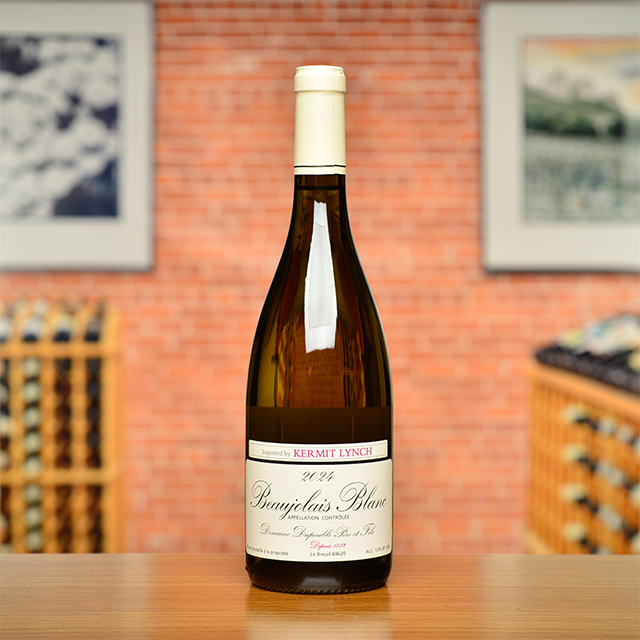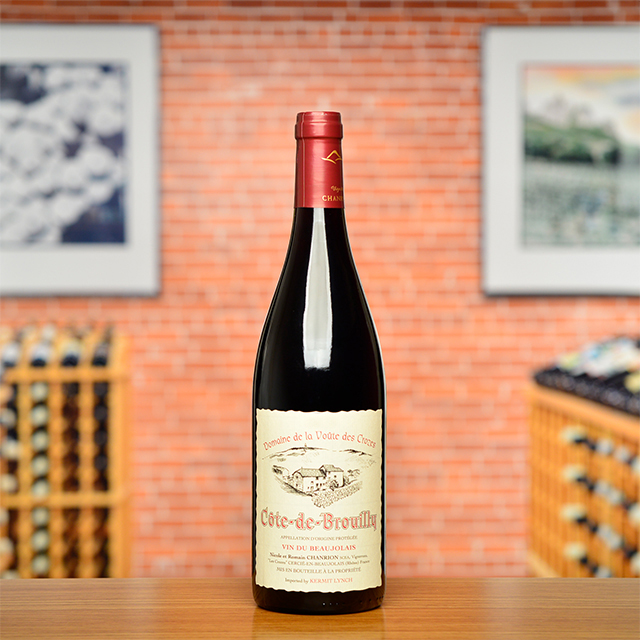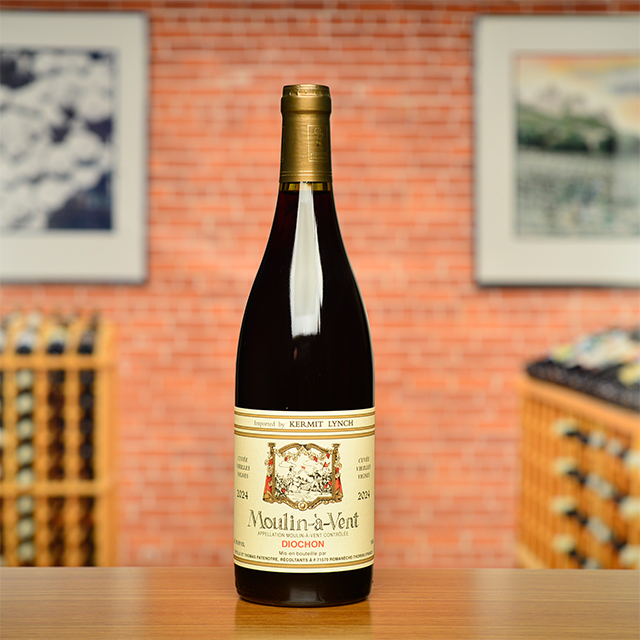Notify me
Beaujolais Built to Last
Beaujolais Built to Last
by Tom Wolf by Tom Wolf
2021 Moulin-à-Vent “Vieilles Vignes”
2021 Moulin-à-Vent “Vieilles Vignes”


Harvest at the domaine
Domaine Diochon France | Beaujolais | Moulin-à-Vent
In a wine landscape in which producers bottle increasingly wider ranges of cuvées, Domaine Diochon has become an outlier, producing one bottling year in and year out, which happens to be the same bottling we have imported for nearly forty years: the old-vine Moulin-à-Vent. In our November 1984 newsletter, Kermit wrote, “There was only one cask of old vines and Diochon was going to blend it in to add substance and character to his other casks. I had to pay a premium to obtain that one cask pure and unblended.”
Today, the wine is made from vines planted in 1920, 1950, and the 1960s. Not much else has changed with respect to this rouge that hails from Moulin-à-Vent, the Beaujolais cru known for producing arguably the region’s most age-worthy wines. Bernard Diochon, who succeeded his father in 1967, once said, “I like tannic wines without heaviness; with fruit and floral aromas. I don’t like weighty wines with hard tannins.” Although Bernard has been succeeded by Thomas Patenôtre, the wine continues to remain true to that sentiment. It contains some tannin—it wouldn’t be young Moulin-à-Vent if it didn’t—but it is beautifully integrated and the wine is ready to drink now if given a little time to breathe. Soulful and savory, with notes of cherries, iron, and smoke, this is cru Beaujolais built to last.


Harvest at the domaine
| Wine Type: | red |
| Vintage: | 2021 |
| Bottle Size: | 750mL |
| Blend: | Gamay |
| Appellation: | Moulin-à-Vent |
| Country: | France |
| Region: | Beaujolais |
| Producer: | Domaine Diochon |
| Winemaker: | Thomas Patenôtre |
| Vineyard: | 50 - 85 years, 5.05 ha |
| Soil: | Pink Granite, sandstone, with a manganese-rich sub-soil |
| Farming: | Lutte Raisonnée |
| Alcohol: | 13% |
More from this Producer or Region

2024 Brouilly “Reverdon”
France | Beaujolais
This bottling is classic Brouilly, balanced and old-school, and showcases the beauty of Gamay.

2024 Beaujolais Blanc
France | Beaujolais
Do not miss this outstanding, value-driven Chardonnay from one of our most beloved French domaines.

2021 Côte de Brouilly
France | Beaujolais
Alex Foillard fashions a Côte-de-Brouilly that strikes a deeper register, saturating the senses with tooth-staining fruit.

2018 Brouilly
France | Beaujolais
A generous dash of plump, sun-ripened fruit enveloping a granite core

2024 Beaujolais MAGNUM
France | Beaujolais
This Beaujolais offers the drinkability of the most effusive Morgons with the frankness of a chiseled Moulin-à-Vent.

2024 Beaujolais
France | Beaujolais
Tangy, thirst-quenching Gamay from a family that has been making Beaujolais for over 500 years.

2023 Moulin-à-Vent “Sous la Roche”
France | Beaujolais
It combines the structural grandeur typical of Moulin-à-Vent with a high-elevation freshness.

2024 Côte-de-Brouilly
France | Beaujolais
Loads of fun—juicy, round, structured, yet always elegant and focused. A classic favorite.

2024 Côte de Brouilly MAGNUM
France | Beaujolais
Château Thivin’s Côte de Brouilly seamlessly fuses pleasure, class, and intellect.

2024 Moulin-à-Vent “Vieilles Vignes”
France | Beaujolais
Moulin-à-Vent has a unique, earthy, chewy edge to it that you just can’t find anywhere else.
About The Producer
Domaine Diochon
About The Region
Beaujolais

After years of the region’s reputation being co-opted by mass-produced Beaujolais Nouveau and the prevalence of industrial farming, the fortunes of vignerons from the Beaujolais have been on the rise in the past couple of decades. Much of this change is due to Jules Chauvet, a prominent Beaujolais producer who Kermit worked with in the 1980s and arguably the father of the natural wine movement, who advocated not using herbicides or pesticides in vineyards, not chaptalizing, fermenting with ambient yeasts, and vinifying without SO2. Chief among Chauvet’s followers was Marcel Lapierre and his three friends, Jean Foillard, Guy Breton, and Jean-Paul Thévenet—a group of Morgon producers who Kermit dubbed “the Gang of Four.” The espousal of Chauvet’s methods led to a dramatic change in quality of wines from Beaujolais and with that an increased interest and appreciation for the AOC crus, Villages, and regular Beaujolais bottlings.
The crus of Beaujolais are interpreted through the Gamay grape and each illuminate the variety of great terroirs available in the region. Distinguishing itself from the clay and limestone of Burgundy, Beaujolais soils are predominantly decomposed granite, with pockets of blue volcanic rock. The primary vinification method is carbonic maceration, where grapes are not crushed, but instead whole clusters are placed in a tank, thus allowing fermentation to take place inside each grape berry.
Much like the easy-going and friendly nature of many Beaujolais vignerons, the wines too have a lively and easy-drinking spirit. They are versatile at table but make particularly good matches with the local pork sausages and charcuterie. Though often considered a wine that must be drunk young, many of the top crus offer great aging potential.
More from Beaujolais or France
2024 Chiroubles “Cuvée Léa”
Guy Breton France | Beaujolais
2024 Morgon “La Roche Pilée”
Jean-Paul et Charly Thévenet France | Beaujolais
2024 Fleurie
Guy Breton France | Beaujolais
2023 Fleurie
Jean Foillard France | Beaujolais
2021 Côte de Brouilly
Alex Foillard France | Beaujolais
2025 Beaujolais Nouveau
La Sœur Cadette France | Beaujolais
2024 Côte de Brouilly
Château Thivin France | Beaujolais
2023 Beaujolais Blanc “Clos de Rochebonne”
Château Thivin France | Beaujolais
2024 Moulin-à-Vent “Vieilles Vignes”
Bernard Diochon France | Beaujolais
2022 Côte de Brouilly
Guy Breton France | Beaujolais
2024 Régnié “Grain & Granit”
Jean Paul et Charly Thévenet France | Beaujolais
2023 Chénas “Les Blémonts”
Domaine Thillardon France | Beaujolais
2024 Chiroubles “Cuvée Léa”
Guy Breton France | Beaujolais
2024 Morgon “La Roche Pilée”
Jean-Paul et Charly Thévenet France | Beaujolais
2024 Fleurie
Guy Breton France | Beaujolais
2023 Fleurie
Jean Foillard France | Beaujolais
2021 Côte de Brouilly
Alex Foillard France | Beaujolais
2025 Beaujolais Nouveau
La Sœur Cadette France | Beaujolais
2024 Côte de Brouilly
Château Thivin France | Beaujolais
2023 Beaujolais Blanc “Clos de Rochebonne”
Château Thivin France | Beaujolais
2024 Moulin-à-Vent “Vieilles Vignes”
Bernard Diochon France | Beaujolais
2022 Côte de Brouilly
Guy Breton France | Beaujolais
2024 Régnié “Grain & Granit”
Jean Paul et Charly Thévenet France | Beaujolais
2023 Chénas “Les Blémonts”
Domaine Thillardon France | Beaujolais
Kermit once said...

Kermit once said...
Let the brett nerds retire into protective bubbles, and whenever they thirst for wine it can be passed in to them through a sterile filter. Those of us on the outside can continue to enjoy complex, natural, living wines.
Inspiring Thirst, page 236
















